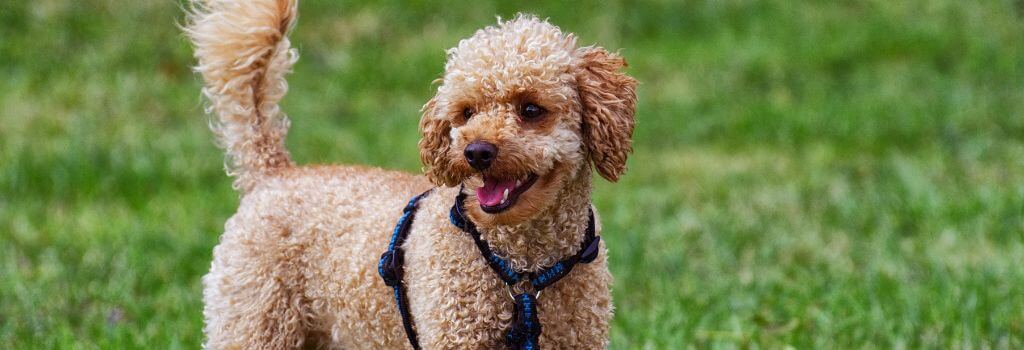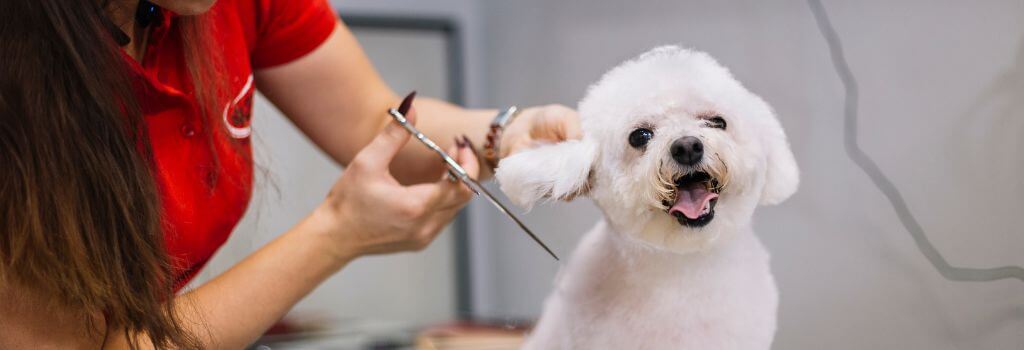When summer is at its peak and the days only seem to get longer and hotter, sunburns, heat stroke, and exhaustion become real concerns for pet owners – especially if their dog or cat loves to spend time outdoors. With harsh heat and high UV indexes, owners can be tempted to give their dog a summer haircut, often shaving them down to keep them from overheating, but what many owners don't realize is that dog summer cuts can often do more harm than good.
In theory, summer haircuts for dogs and cats make a lot of sense – the hotter it is, the less you want to cover your body, right? After all, we wouldn't want to wear a heavy fur coat out in the sun, so why should our dogs. But while that line of thinking is logical, it ignores the natural features of a dog's coat that are actually meant to protect them from the sun and heat. So before you pick up those clippers, check out the importance of a dog's coat for heat protection and learn about some warm-weather grooming alternatives you can take advantage of instead.
Why a Dog Summer Cut Isn't Always the Best Idea
No More Natural Insulation
While it might sound counterintuitive, removing a dog's natural coat can make it harder for them to stay cool. Our dog's coats are designed to help them regulate their body temperature, both in the summer and winter. While dog fur isn't a perfect insulator, it does do a great job of trapping air against a dog's body. In colder weather, a dog's coat will trap warm air against their body to keep their body temperature from dropping too much. Breeds with double coats like Huskies, Golden Retrievers, and German Shepherds rely on this natural system for thermoregulation and benefit the most from their combination of guard hairs and undercoats.
But a dog's coat doesn't just trap heat to keep your dog warm; the opposite effect can occur in the summer months, with a dog's coat trapping cooler air against their body and keeping their temperature from rising too high. Shaving a dog's coat too far down for a dog summer cut removes that valuable insulation and disrupts the dog's ability to stay cool on their own.

Less Protection from Harmful UV Rays
Dogs are at risk for developing sunburns just like we are. Their coats act as a natural barrier, protecting their skin from harmful UV rays. When a dog's coat is shaved down too short, they lose a majority of their natural sun protection, making them far more susceptible to painful sunburns and long-term skin damage like infections or cancer.
Owners of dogs with light-colored coats and fair skin should be extra careful about dog summer cuts, as these dogs are more vulnerable to the sun's harmful rays and account for a high portion of dogs who have suffered from sunburn.
Increased Risk of Heat Stroke
Because a shorter coat doesn't always make for a cooler dog, it's important for owners to know that by removing too much of their dog's hair they can actually increase their risk for heat exhaustion and heat stroke.
Overheating, also known as heat exhaustion, occurs when a pet's body temperature rises excessively, triggering a response where blood is directed to the tongue, gums, and other membranes in an attempt to release the excess heat. Heat exhaustion is a condition that can escalate rapidly, as dogs are not always able to cool themselves effectively – especially when their natural cooling is inhibited – potentially leading to a dangerous breakdown in normal bodily functions. Heat exhaustion progresses to heatstroke when a dog's internal temperature hits 105 degrees Fahrenheit (remember a dog’s normal temperature should fall in the range of 99.5–102.5 °F) and can have extreme and long-lasting consequences for a dog's health.
Damage to the Undercoat and Issues with Hair Regrowth
Remember those double-coated breeds we talked about? They aren't just at risk for heat related illnesses and health complications when given an inappropriate summer cut for dogs; shaving can actually damage their coat health. Their undercoats are designed to shed and regrow seasonally, but shaving can disrupt this cycle and result in patchy regrowth, only further exacerbating issues with temperature regulation in both summer and winter.
Injuries from At-Home Grooming Accidents
Grooming your dog at home can strengthen your bond and save money, but be aware of the risks of cutting or shaving your pet yourself. If you're not confident with clippers or scissors, or if your pup is squirmy, it's easy to slip. Areas like the neck and armpits can be tricky, and even with good intentions, accidents can happen. Many emergency vet visits stem from at-home grooming injuries, with accidental cuts being one of the most common issues. When in doubt, it's always safest to call in the pros or ask your vet for advice before attempting a DIY haircut.
When It Is Okay To Cut Or Shave A Dog In Summer
Now that we've discussed some of the reasons that a summer cut isn't always a great idea, let's cover a few instances where grabbing those clippers and getting to work on a dog summer cut can be beneficial for dogs.
When There's Matting
While shaving healthy and well-maintained coats doesn't do a whole lot of good for most dogs during the summer, matted and tangled coats are another story. Severely matted coats can trap heat, restrict movement, and harbor bacteria or parasites, putting a dog at risk for more than just heat stroke or sunburn.
When mats are allowed to form and become tight to a dog's skin, shaving may be the only humane option to provide relief. As a responsible pet owner, you should be keeping up with regular brushing and grooming to prevent severe mats from ever forming in your dog's coat.
If the Breed Has Hair, Not Fur
Poodles, Bichon Frises, Maltese, Shih Tzus, and Portuguese Water Dogs are all breeds with a unique exception when it comes to summer cuts for dogs. These dogs have hair instead of fur, which means they don't shed seasonally and require regular haircuts to prevent overgrowth and unhygienic conditions. For breeds with hair, a properly done summer trim can help keep them comfortable and make grooming more manageable, especially if the dog is prone to getting dirty during walks or outdoor playtime.
If the Dog Has Skin Issues or a Medical Condition
There are some cases when shaving or shorter haircuts during the summer are unavoidable, such as for dogs undergoing surgery, medical procedures, or other treatments. In these cases, vets might recommend shaving to allow medicated creams or ointments to penetrate the skin, to clear an area for surgery, or to get a better view for diagnosis. Always follow your veterinarian's recommendations before shaving for medical reasons.
Can I Shave My Cat?
With all of this talk about summer haircuts for dogs, you may be thinking, "What about my cat?"
Generally, cats don't need to be shaved unless there is a specific medical reason or they have extreme matting in their fur. Like dogs, cats are excellent at self-regulating their body temperature, and they naturally do a great job of maintaining their own coat's cleanliness through self-grooming.
Shaving a cat without necessity can cause stress, disrupt their natural coat, and increase their risk of sunburn or skin injury. If the temperatures are so extreme that you're worried about your cat overheating or getting sunburnt, bringing them inside until they cool off is a safer and more practical option.

Warm Weather Grooming Alternatives: What You Can Try Instead of a Summer Cut for Dogs
While shaving your dog down in the summer isn't always a great idea, there are a few grooming alternatives that you can keep up with to keep your dog cool and comfortable in the warmer months.
- Frequent brushing: Regular brushing your dog's coat helps remove loose undercoat, reduce shedding, and improve airflow to the skin, making their coat's natural insulation that much more effective. Brushing and removing loose and shedding fur is especially important for those double-coated breeds when they are going through their seasonal periods of shedding. If shedding is a major concern for your dog, reach out to a professional groomer that offers deshedding services. These treatments use special tools and conditioners that loosen and remove excess fur safely to keep your pup cooler.
- Light trimming: For breeds that tolerate trimming, such as Poodles or Schnauzers, you can request a summer cut that shortens — but doesn't fully shave — their coat. Ask your groomer for a "puppy cut" or a "teddy bear cut" that keeps about ½ to 1 inch of fur left on their body. This type of cut can keep your dog cool without removing their natural protection from the sun and high temperatures.
- Cool baths: Summer baths can be a great tool to not only help your dog cool off, but also remove dirt, oils, and allergens from the skin and coat to keep them squeaky clean. Be sure to use cool or lukewarm water to keep them comfortable and be sure to dry them off completely before going outside and into the sun.
- Cooling accessories: Cooling vests, mats, or bandanas soaked in water can help regulate your dog's temperature on hot days. Some vests and other clothing can also be used to help protect dogs from sunburn and skin damage while they enjoy a little fun in the sun.
Regardless of how you decide to manage summer grooming for your dog, be sure to prioritize their access to fresh water and shade while they're outside. A dog's coat can only provide so much cooling and protection from the sun; it's up to owners to follow best practices for sun exposure and warm weather to keep their dog healthy and happy.
If you have questions and you'd like to reach out to us, you can call us directly at (920) 477-3003, or you can email us at [email protected]. Don't forget to follow us on social media Facebook, Instagram.

